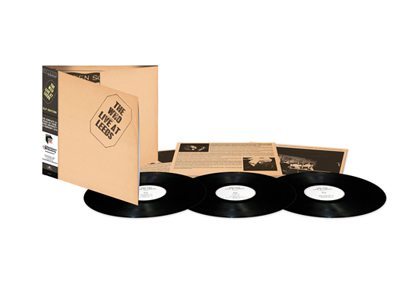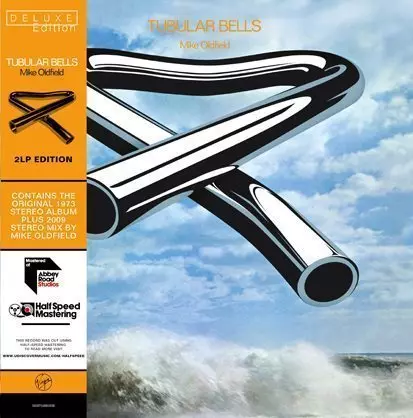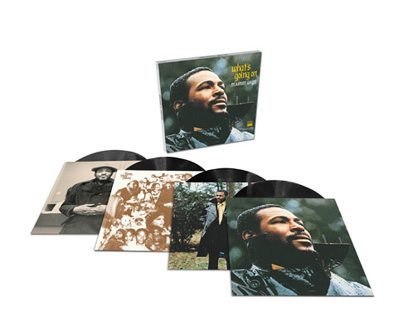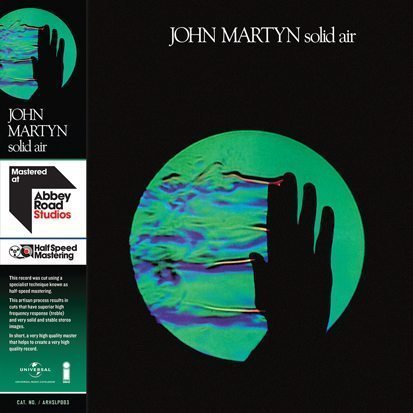All You Need To Know About Half Speed Masters

In over 15 years of half-speed mastering, Abbey Road engineer Miles Showell has mastered the art of creating the finest audio-quality vinyl pressings available, with his specialist work creating a whole listening experience for some of the most iconic albums of all time. The latest additions to his aresenal of Abbey Road half-speed mastering series of releases are the entire 1971-2016 Rolling Stones studio albums, which have been collected together for the The Studio Albums Vinyl Collection 1971-2016, which is due for release on 15 June.
Click to load video
They join other illustrious albums, among them INXS’s Kick, ABBA The Album and seminal Brian Eno solo albums Here Come The Warm Jets, Taking Tiger Mountain (By Strategy), Another Green World and Before And After Science, which now take their place alongside half-speed reissues of Marvin Gaye’s What’s Going On, Amy Winehouse’s Back To Black, The Who’s Live At Leeds, Mike Oldfield’s Tubular Bells and James Brown’s Live At The Apollo Volume II.
For the original 1973 mix which features on Disc One of the deluxe edition Tubular Bells, Showell had access to the original ¼” Dolby A encoded analogue master tape. “I did a vinyl specific transfer to high resolution digital applying only minimal EQ and absolutely no digital limiting,” he says, adding, “I used an ex-Olympic Studios AMPEX ATR-102 tape machine for this, which I have fitted with my own Flux Magnetics tape heads (this machine and head combination sounds fabulous and is pretty much as good as it gets).” The lacquers for this edition were cut at half speed from this new transfer. The 2009 mix which features on Disc Two is sourced from the original digital master.
The original master tape also played a part in providing the source audio for What’s Going On, as Showell cut the record from a high-resolution transfer made from the master tape in the US. Of course, Motown’s production style has influenced countless of musicians over the years, not least Amy Winehouse for Back To Black. The original 2006 mix of the album, however, features a “Motown pastiche compression”, as Showell puts it, which resulted in some inherent distortion to the audio. Showell has removed these from the half-speed mastered Back To Black, cutting from “a vinyl specific newly re-mastered digital transfer made from the original studio mix files”. “I applied no digital limiting whatsoever to my new transfer as this is totally unnecessary for vinyl records and only serves to lower the audio fidelity,” Showell says, adding, “The result is a better-sounding record than was previously possible. It still sounds like the 60s, but it is a lot cleaner and more open sounding than it was.”

Without studio masters, the two live albums in the series have slightly different sources. Also still sounding like the 60s is James Brown’s Live At The Apollo, the best audio of which is a standard resolution audio file – the only format in which the concert exists. For Live At Leeds, however, Showell had access to the highly praised mix by noted producer and engineer Jon Astley, courtesy of a high-resolution digital file that provides the best audio available of that album.
Below, Miles Showell discusses why half-speed mastering at Abbey Road Studios offers the finest listening experience available today…
What exactly is half-speed mastering?
It’s a vinyl cutting process whereby the disc-cutting lathe for an LP is run at half the speed – so for an album that would be 16 and two thirds, which is half of 33 and a third – and the master source is run at half the speed as well. So they’re locked together, both of them running at the wrong speed – slowly, basically.
Records are a mechanical recording of the music: think of sound waves coming out of the speakers as a wavy groove on the disc, and that’s kind of what they are – it’s pretty crude technology. So the longer you can spend carving that intricate groove, the more accurately it can be done. For example, if I was cutting a song with a tambourine in, you may have a 10 kHz component within that tambourine. That’s 10,000 cycles of air per second. In order to record that in the disc, you’ve got to have 10,000 vibrations per second cut into the disc, which is obviously quite stressful. You’ve literally got some coils inside – a bit like the little coil you have in a headphone speaker or something – that vibrate a stylus to etch the groove into the disc. So if you can halve all that, what is difficult-to-cut high-frequency information becomes relatively easy-to-cut mid-range information, and you can generally get it on far more cleanly and accurately. Nothing’s getting pushed to its limits, nothing’s getting stressed, it’s all just gently sailing on through and doing a nice clean cut.
Ultimately, if you can get a nice clean cut, then as long as the factory can make a good pressing, it will sound better at home. No matter how good your turntable is, if the cut and the pressing aren’t up to much, it’s not going to sound good. So, it all starts from the cut.
Though it’s horrendous to listen to for me as an engineer – it’s just mind-numbingly dull – when you play the record back at the end of the process, it’s just like, Wow. It’s kind of otherworldly, really. You get an amazingly clean high-frequency response, beautiful stereo stage – the soundstaging is really precise. You can close your eyes and imagine that people are playing the music in your room.
How do you do it, step by step?
The most important piece of equipment is probably the disc-cutting lathe. We have a Neumann lathe, which we’ve had modified to be able to run at half speed, because it’s not just a case of pushing a button for it to run slower.
All records that are made had an equalisation curve applied to them to reduce hiss and to make it cut more efficiently – it filters out some of the bass. And then your amplifier basically turns down the high frequency and puts all the bass back. At half the speed, the frequencies are in the wrong place. It’s expecting to roll off the bass in a certain area, but if you’re playing it at lower frequencies because it’s half the speed, then the EQ curve is working in the wrong area – the wrong frequency range. So we had that specially modified circuit built, and some other mods have been made to the lathe to make it work more efficiently at half speed. So that’s probably the most important thing.
Generally, I’ve been doing it digitally, which actually has its advantages. People go, “Why can’t you cut from the master tape?” but, actually, I’m doing it through high-resolution digital and making vinyl-specific transfers – so I’m not doing lots of mad compression and limiting to make it loud, like you would do for the “loudness wars” for a CD or download file. It has all sorts of advantages in terms of micro-management of the audio. You can fix the de-essing [reduction of sibilance in the vocals] and all sorts of other little problems.

Also, these tapes are all getting a bit old now. Tubular Bells was recorded in ’72/’73. You run that master tape through the machine and it wears it away – it damages it. The more times you run the tape, the more wear and tear it’s going to suffer. So it’s not good practise to continually play and play and play and play old masters, because they’re getting delicate now.
Do the digital masters come from the analogue tapes?
They would have been done in the last four to five years. A lot of the tapes are in America – there’s no way they’re going to ship tapes across the sea just for me to cut some records. The days of flying tapes around the world are long, long gone. So they would have been made for a high-resolution archive copy, or a Blu-ray audio release.
There’s digital and there’s digital. You’ve got very compressed limited CD files, which don’t sound that great – it’s just too loud and too in your face, so that it jumps out of the speakers. Or you can do it in high resolution, a real clean transfer, no artificial compression that’s not needed for a vinyl cut.
But it’s better to use those high-resolution files than to dig the tape out and run it once again because you’re basically scraping it against a metal head. And that will damage it each time – albeit only very slightly. But once you’ve run it 50 or 60 times, that builds up. You’re effectively moving the oxide bits around, so you’ve got some of it in the wrong place; some of it has worn away and doesn’t sound as good as it could. So that’s another reason why we try not to do it too often. We want to preserve these things for future generations.
Plus, there’s a terrible problem with tape from the mid-70s to the late 90s, in that you need to bake it to make it play. You can only bake them about seven times before they fall to pieces – they literally just die. So, really, putting out high-quality records is probably the best way to preserve music for the future, because, in 100 years, they’ll still work. We’ve got 100-year-old records that still play.
John Martyn’s half-speed mastered Solid Air was taken from a digital file that I’d made off the tape. Nobody is saying, “Why isn’t it cut from tape?” Everyone who’s heard it just goes, “Wow. I wasn’t expecting it to be like this.” Even people who are really skeptical. I had someone who was really skeptical: “I don’t see the point. I’ve got an original pressing that’s in brilliant condition. Why would I need to bother?” I said, “Well, I haven’t heard the original pressing, I don’t know.” They had the advantage, in 1973, of the tape being in mint condition, but I’ve got a better signal path. Who’s gonna win? I don’t know. But he actually said to me that mine was better, so I was quite chuffed with that.
So you’ve got your lathe. You’ve got your source audio. Then what do you do?
As little as possible. I’m doing as clean a transfer as I can. If I have to do any equalisation or compression, it’s from an artistic point of view, rather than for the sake of it. Just because I’ve got a whole desk full of tools to play with doesn’t mean I have to put them all over everything. Because, ultimately, every time you put a bit of equipment in the signal path, it will smear the sound to an extent. So I try and keep it as clean as possible – there’s no point in going mad on stuff unless you need to. And a lot of these albums are really nicely recorded. What’s Going On especially is a great-sounding record. The last thing I want to do is start going crazy with lots of compression and EQ. Why mess with near-perfection?
You will get a track where maybe the tape’s been damaged, or the engineer was having an off day when he mixed it, and it’s always been a bit muddy and dead-sounding. In those cases, I can gently bring some more life to it. But I’ll only do that if I need to, not because I can.
Once it’s done and in the system, then I’ll run through it and do any extra de-essing, which I’ll usually do digitally, because you can micro-manage it and just fix the “s” sound – “s”s and “t”s in the vocal can distort on record. The human voice and the piano are the hardest things to track. I can cut them fine, but getting a cartridge to follow the groove and play it back without distorting is the challenge. So you have to limit the “s” sounds and take some of the energy out of it.
Ordinarily, for a normal cut, you have a limiter which will come into play. But it can’t spot the difference between a bright “s” in the vocal and a big snare drum hit, or a bright guitar or tambourine. All sorts of things that actually don’t need to be limited will get diminished by the limiter. So, by doing it this way, I can zoom in and just treat the area that needs fixing, zoom out again, and the surrounding audio is completely intact. So all the snare drum hits and the bright guitars are untouched, but the vocal is controlled. It takes ages longer, but if you put that extra effort in, you’re basically getting everything that you need and you’re only diminishing the “s”s where you have to.
Once that’s ready, we’re good to go to the lathe. And I play straight from the high-resolution file, I don’t go through any more analogue gear until it hits the lathe. It goes straight to the analogue-to-digital converter, into the cutter head. Or the cutting amplifiers. So I’m not passing it through the console again. I’m not passing it through any other stuff that it doesn’t need to go through. Again, I’m trying to keep everything as pure as possible. It’s more complicated to patch it up that way, and more of a faff for me. But, you know, I’m not doing it for ease, I’m doing it for the best possible result.
What’s the most stressful aspect of cutting at half speed?
Being careful with old tapes. Rewinding them, if you’re not careful, an edit falls apart and the loose bit of tape is flying around – it either gets lost or gets caught on something and tears. And you’ve then destroyed a priceless master. Rewinding is the most nasty, stressful part, because you’re dealing with a lot of people’s favourite records of all time. I don’t want to be the person who says, “Yeah, I know you love Tubular Bells, but I smashed it.” I am literally stood over my tape machine, ready, if an edit falls apart, to grab the wheels as they’re spinning.
Aside from that, the whole beauty of half-speed cutting is that it’s not that stressful. You’re sitting there and it’s all sailing away very slowly. You’ve just got to concentrate. Especially if you’ve got an album of live music, where all the tracks crossfade, because it’s actually very hard to hear where the track transitions are. I once did an album for Queen, the Flash Gordon soundtrack, at half speed. It’s one long file and it’s all orchestral, but there are six or seven tracks within that, and you’ve got to know where to hit the button. That’s pretty tough. But other than that, it’s actually quite easy.
So if it takes you twice as long to do the actual cut of the record –
Four times as long, actually. Because I can’t hear what the cutter head’s doing. In a real-time cut, I monitor at the end of the chain. Music goes into the cutter head that cuts the parts, and then has an output feed, which then goes back into the monitor. So I’m hearing it after what’s been sent to the cutter head.
I can’t really hear what that’s doing at half speed, so we do an acetate for every single one, which I will then check. So I have to cut the acetate at half speed, take it home, sit with the headphones on and check it, and then, if I’m happy, send it on to the client. Once everybody’s happy with the acetate, then we go ahead and do the cut. So each album has to be cut twice, even after doing all the processing.

How did you get involved with half-speed mastering?
It’s a long story, but I’ve been mastering records since I left school – it’s been 32 years since I started. In those days I was a junior making lots of cups of tea, running cassettes for people and doing other menial stuff.
Before I started working, my dad had an independent record shop and I had some albums that were cut by a guy called Stan Ricker. They were issued by Mobile Fidelity Sound Labs, who are still going, and who would license classic albums and do limited runs, very high-quality half-speed cuts, very nice pressings – they pressed them in Japan at the time. I had a few of these records and they sounded amazing. And I always said to people I worked with, “We should do half-speed mastering, it’s great!” And they just said, “Oh no, it’s too complicated. It’s lots of faff, you’ve got to adjust the tape machine, you’ve got to change this, you’ve got to fiddle with the lathe. Oh no, no, no.”
About 15 years ago, at my former employer’s, I mentioned it to one of the tech guys there. He said, “Come on then, let’s give it a go.” So we did a very rudimentary test, to see if it was even worth pursuing. And though it wasn’t the best-quality cut in the world, we could hear that there was an advantage. So we then pursued it and built the prototype board there. And since that time both the tech guy and I have left that establishment and we’re both freelance, so I brought my technology to Abbey Road. I persuaded management to adapt one of the lathes and they went for it.
How long do you think the equipment is likely to last?
Well, Neumann built the lathe that I’m using in the early 80s, and it was built for a 10-year life cycle. We’re still using those. We have to, because all the guys who worked for Neumann – who built the lathes – they’re all dead. So there will be no more disc-cutting lathes. And they didn’t write everything down. So we have to look after what we’ve got. But, thankfully, they built them like tanks.
So you’re saying no one’s ever going to build a lathe again?
Not to the quality that Neumann could. People say, “Oh yeah, it’s easy.” No. There were eight guys there, who’d been doing it for 50 years each. You had 400 years’ collective knowledge of how you build these things. But, thankfully, they’re unbelievably over-engineered. One of the motors that drive the cutter head across the disc, for example, is a Ministry Of Defence-specification part. I think it’s the motors from an air-force bomb door. It’s a case of: “Well, we could do it cheaper, but we’re not going to. We’re going to make it amazing.” Which is paying off now because the stuff still works.
It needs to be looked after. You’ve got to oil it in the right places and be careful with it – you can’t go thumping the buttons and bashing it up. But if you look after these machines, they’re well made and they can carry on for quite a long time yet.
I don’t think the supply of disc-cutting lathes is the issue with keeping records going. There’ll be other problems: keeping the presses working in the factories and keeping the supply of blank discs that we cut into – the lacquers – good. But everybody’s working flat out. The factories are fully booked, all the cutting rooms are fully booked, the lacquer supplies are absolutely at full stretch. Everything’s fine at the moment, but who knows how it’s going to shake down in the end? Five years ago you’d never have predicted where we are now with records, so it’s hard to say. I don’t foresee a problem.
Even if there were more lathes on the market, it takes years to learn how to cut, even at real time, because there all sorts of pitfalls with records – things that just don’t work, like you have to kind of cajole the audio just to fit on a disc. And then once you’ve sussed that out, you have to throw all that away and learn a whole new set of skills to master at half speed. So it’s not the sort of thing you can pick up in a couple of weeks. And there aren’t enough people willing to learn. I’m considered quite young at this and I’m nearly 50.
I think we’re good for another 20-odd years. After that, who knows? The way the world is changing so quickly, 20 years is a very, very long way away.

In what ways does half-speed mastering enhance the sound?
As long as the pressing is really good and clean, and as long as you don’t have one of those nasty little cheap £80 all-in-one box record players – if you’ve got anything that costs about £200 and upward – it will sound better. You don’t need to have audiophile gear to be able to recover the nicer-sounding audio from these half-speed cuts. Obviously, the better your turntable and your arm and your cartridge, the more you can pull out of your groove. But it doesn’t need to be £50,000 esoteric crazy stuff to hear the difference. It’s chalk and cheese.
We used to check test pressings on cheap, crappy turntables, but we came to the conclusion that we were downgrading the audio so that it plays on a piece of crap. And even if you downgrade it, it still sounds like a piece of crap, and then everybody else gets crap audio. So we’ve given up playing it on the worst possible record players. Our attitude now is that, as long as you don’t have the really cheapest nastiest USB turntable, you’ll be able to hear a difference. And the beauty of it is, if you know how to look after your records, and you keep them clean, keep your fingers off the playing surface, in 10 years, when you’ve got a better record deck, you’ll be able to get more audio out of them.
What would you say to anyone who thinks “half-speed mastering” is just another fancy name to stick on a reissue?
Have a listen for yourself. Most of the people hear the difference. Trust me, I wouldn’t be sitting here for hour after hour if it didn’t make a difference. If you’re going to devote 45 minutes of your life to something, then it does sound amazing – so why not make it as good as it can be?
Click to load video


